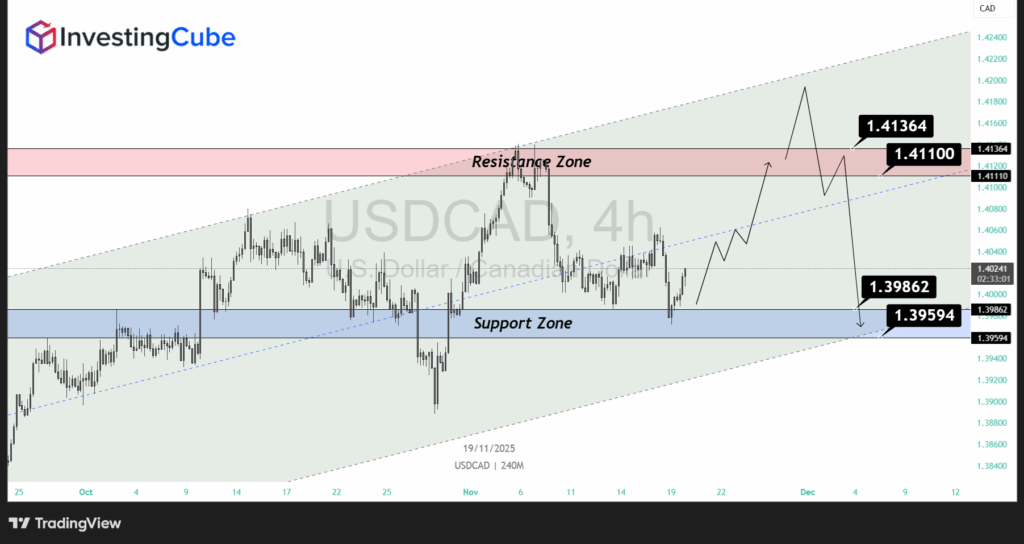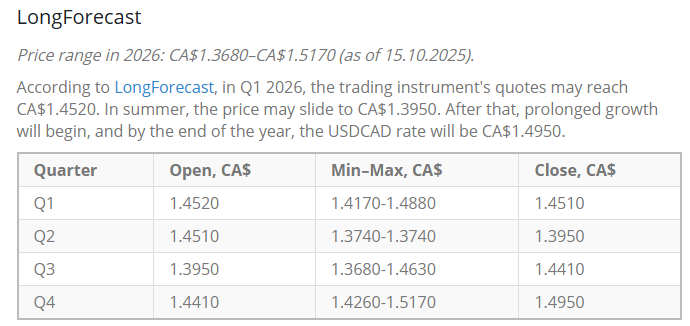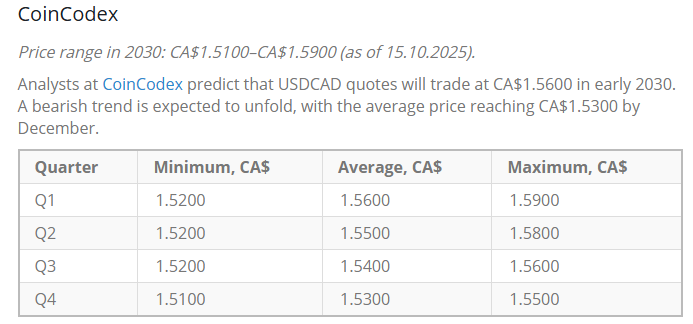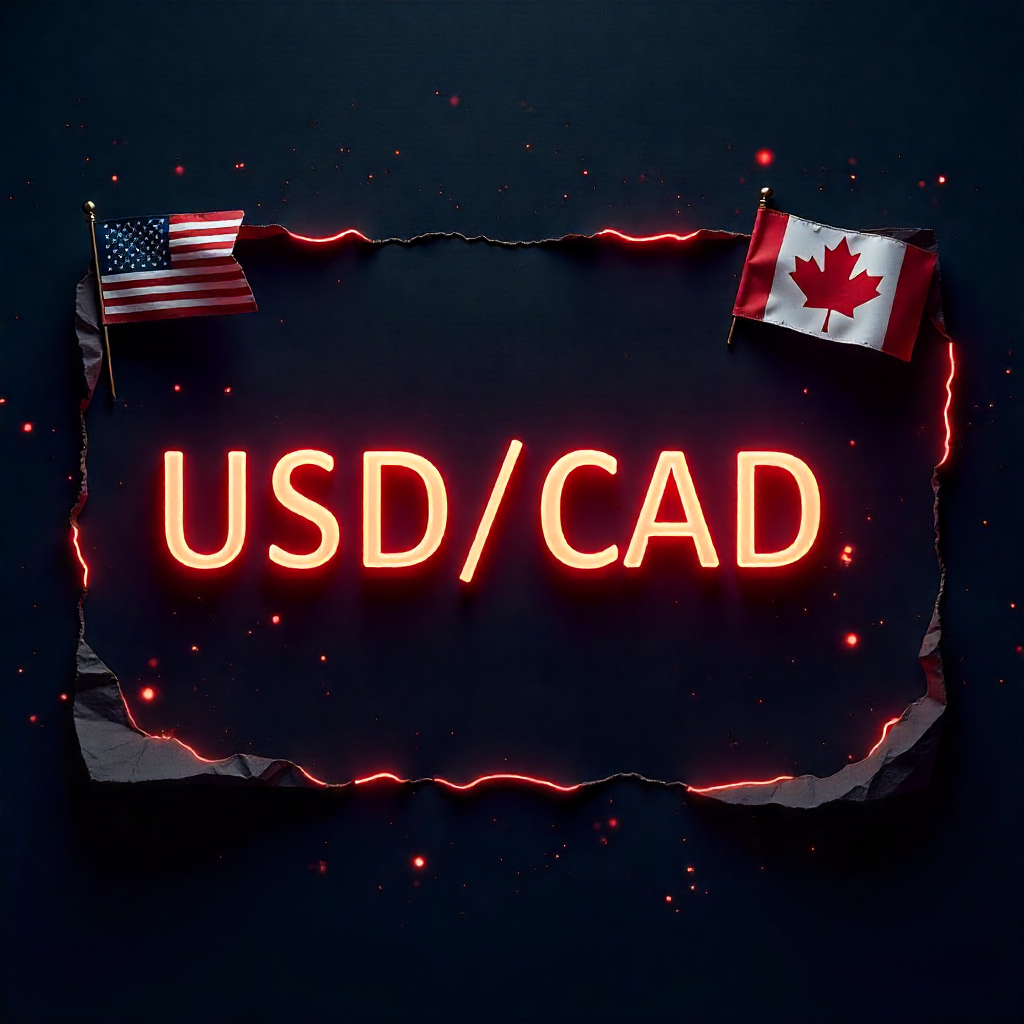- USDCAD is still going strong on oil and the Fed - BoC rates spread.
- In 2026 projections, dips to near 1.33 - 1.35 are also proposed for the event of a relative policy convergence.
- Longer-term models signal a 1.32 - 1.38 fair range for 2030, with scenarios of higher volatility being conceivable.
- By 2040, structural shifts in energy demand and trade might drag USDCAD toward a 1.20 - 1.30 mean cycle.
Market Drivers & Exchange Rate Factors
The USDCAD rate continues to be petroleum-influenced an interest rate spread between both the Bank of Canada and the Federal Reserve. “Canada is a leading crude exporter, making the Loonie sensitive to fluctuations in WTI prices and oil shocks; lower oil is typically bearish CAD, supportive of USDCAD strength,” analyst at Scotiabank explained.
Money-market pricing also reflects traders’ fine-tuning views for Fed and BoC policy paths following recent U.S. data which struck an upbeat note on labor conditions, but decelerating dips in inflation.” Rate spreads continue to make very modest contributions for a USD,” one investment bank said, writing that near term positioning remained skewed towards the upside unless oil stabilized.
Technical Analysis & Key Levels

USDCAD is inside a large upward channel, with the 4-hour chart, still showing price action behaving in accordance with this structure. Currently, the pair is hovering around the mid-channel, while the momentum has turned a bit upwards as long as the lower line remains intact.
One key support area can be found at 1.3986 – 1.3959 since buyers have defended this level several times already in the past. A continued to close under the zone would indicate weakening trend momentum and not rule out a test of the lower end of the ascending channel.
To the upside, a strong resistance area can be found at 1.4110 – 1.4136. This area has contained several rally efforts. A clear breakup above 1.4136 would open the door for further upside towards the upper trend channel; on the other hand, rejections that a zone would invite a return of sellers.
The chart also shows two likely pass scenarios:
- Bullish continuation – An initial climb toward a resistance band around 1.4110 – 1.4136, followed by the possibility for additional breakout attempts from there.
- Rejection setup – Quick move the resistance followed by an intense pullback toward the area of support and in line with the last couple of failed tops.
All things considered, it seems that USDCAD is at a key turning point and that how price will be impacted by the interaction of the ascending channel with the highlighted supply-demand areas will offer traders clues as to what is next to come.
USDCAD Forecast 2026

Projections for 2026: There is a wide dispersion of forecasts from institutions, but most see a softening from where things are now. RBC Capital Markets estimates that USDCAD could dip to 1.33 to 1.35 levels by-mid 2026, should oil remain stable and the policy divergence close (or if the Democrats initial cuts are not offset by additional tax increases after).
Even more USD bullish — usually stemming from poor global demand for commodities and a recovery in the USD — brings the pair towards 1.45, but if the allergy prices bounced and BoC stays more hawkish than Fed, strategists say there is a room for USDCAD to retest the 1.30 to 1.32 region.
USDCAD Forecast 2030

More extended forecasts up to 2030 tend towards rather stable values. According to a statistical model from the Traders Union, the pair’s fair range is around 1.37, and other institutional scenario suggest a band of 1.32 to 1.38 under ordinary commodity cycle circumstances.

However, alternative high volatility outcomes exist. Oil-correlated models favored by some forecasters are also looking higher to USDCAD in a wake of sustained export-sector underperformance or continued de-strengthening in USD.
Strategists, however, generally warn that the 2030 prognosis is susceptible to structural changes in global energy demand and whether Canada successfully diversifies its export mix.
USDCAD Forecast 2040
In 2040, the USDCAD path increasingly relies on long-term macro forces (such as green-energy transitions) and productivity imbalances alongside North American trade structures.
Long-horizon models suggest a more favorable terms-to -trade environment for Canada could, in time, draw the exchange rate closer to 1.20 to 1.30 (and higher still if demand for energy commodities remain robust).
Alternatively, some warn of a soft Canadian economy, or prolonged USD premium keeping USDCAD buoyed above 1.50. The bulk of baseline forecasts hovers around the 1.30 level, which would essentially constitute a return to the cycle mean after two decades.
Frequently Asked Questions
What is the current market sentiment for USDCAD?
USD wary eye sentiment still tries to weigh on the following oil prices and shifting FED Outlook. CAD has been underperforming amid weaker commodity markets.
Why is the USDCAD exchange rate rising or falling today?
USDCAD trades tend to respond to fluctuations in oil prices, monetary policy, expectations and swings in risk appetite globally. Stronger U.S. data or weaker crude drives the pair up.
What are some of the main USDCAD themes?
Analysts are divided over the sustainability of Canada’s energy-linked expansion, the future of U.S. exceptionalism and whether interest-rates will return to normal.
What is the best time to trade USDCAD?
Liquidity is the highest during North American trading hours, particularly around U.S. and Canadian economic releases or oil-market data.




 META
META  ^NDX
^NDX  BTC-USD
BTC-USD  XRP-USD
XRP-USD  SUZLON.NS
SUZLON.NS  CAD=X
CAD=X